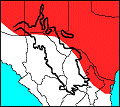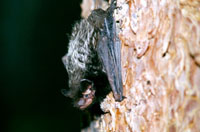


Silver-haired Bat (Lasionycteris noctivagans). U.S. Geological Survey/photo by Keith Geluso.
This bat is medium-sized and nearly black across its body. Its upper and lower parts are sooty brown or black with white tips of hair giving the animal a frosted appearance. The rounded ears and the membranes are also brown or black (Davis and Schmidly 1994). It has a long tail within a long interfemoral membrane (a membrane connecting the hind legs and tail), the basal half of which is furred on the dorsal surface. Adults measure about 102 mm in total length and are approximately 7 g in weight (Cockrum 1982).
During the daytime, the Silver-Haired Bat retreats into tree cavities, spaces under loose bark, or, sometimes, buildings (Davis and Schmidly 1994). It is a migratory species between summer and winter climates, finding easily protected spots in the warmer months and more secluded places for hibernation in the colder parts of the year (Whitaker 1980).
Lasionycteris noctivagans has a broad but erratic distribution across the northern United States and into southern Canada. It has been reported, however, to frequent different parts of Texas such as the Gulf Coastal Plains, Trans-Pecos, and Edwards Plateau (where it is a fall-spring migrant) (Davis and Schmidly 1994).
These bats feed on smaller night-flying insects, usually moths, and feeding flights begin after it has become completely dark (Cockrum 1982).
It is possible for small maternity clusters of this species to form in hollow trees or abandoned bird nests. One or two young are born around the months of June or July. They are black and wrinkled at birth and are capable of flight around 3 weeks of age (Davis and Schmidly 1994).
The frosty markings of this particular bat make it rather beautiful to behold. It is solitary by nature and emerges in the evening for feeding (often after other bat species have already emerged). This flying mammal has an excellent homing instinct. It was recorded that one member of this species traveled 107 miles to its home roost (Whitaker 1980).
Cockrum, E. L. 1982. Mammals of the Southwest. University of Arizona Press, Tucson, 176 pp.
Davis, W. B., and Schmidly, D. J. 1994. The Mammals of Texas. Texas Parks and Wildlife Press, Austin, 338 pp.
Whitaker, J. O., Jr. 1980. The Audubon Society Field Guide to North American Mammals. Alfred A. Knopf, Inc., 745 pp.
Todd Spurgeon, Student, October 1997.
Last Update: 23 Jul 2009